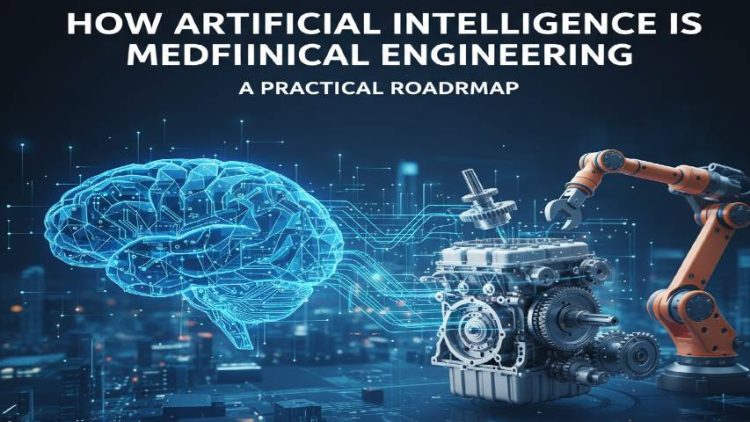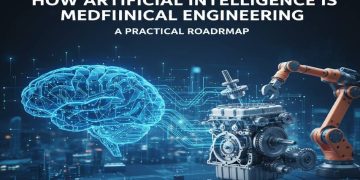Mechanical engineering has long been built on physics, materials, and innovation. But in recent years, the way engineers apply that expertise has changed dramatically.
For decades, teams spent endless hours sketching, modeling, simulating, and validating designs by hand.
Today, artificial intelligence (AI) is stepping in as a true engineering co-pilot — capable of generating design concepts in minutes, predicting breakdowns before they occur, and detecting defects too small for the human eye.
From the first sketch to the final maintenance check, AI is rewriting the engineering playbook.
This article walks you through how AI enhances every step of the modern mechanical engineering workflow.
The AI-Powered Engineering Workflow
Every mechanical innovation typically moves through these stages:
1. Concept Development → 2. CAD Modeling → 3. Simulation → 4. Prototyping → 5. Manufacturing → Let’s explore how AI speeds up and improves each one.
- Concept Development — Turning Vision into Viable Designs
The Challenge: Early design is often creative but slow. Brainstorming and evaluating options take time, and decisions depend heavily on experience or intuition.
AI’s Role: AI brings structure and data to creativity.
- Generative Design: Instead of manually exploring concepts, engineers define constraints—like weight, cost, or performance—and AI produces hundreds of optimized possibilities.
- Smart Research: Natural Language Processing (NLP) tools can scan past projects, patents, and customer feedback to identify what really matters for the next design.
Examples in Use:
- Autodesk Generative Design builds optimized geometries that balance strength and weight.
- Leo AI converts text prompts into 3D shapes, turning early ideas into digital models instantly.
With AI-driven concepting, teams spend less time on repetition and more time pushing boundaries.
- CAD Modeling — Designing with Intelligence
The Challenge: Creating detailed CAD models is precise but repetitive. Engineers often handle tedious edits and compliance checks manually.
AI’s Role: AI assistants embedded in CAD tools now automate those micro-tasks. They learn from user actions, predict necessary adjustments, and even flag manufacturability issues in real time.
Tools Making It Happen:
- Siemens NX uses AI to update designs automatically when dependencies change.
- PTC Creo offers live manufacturability insights while you model.
The result? Faster workflows, fewer errors, and more creative headspace for problem-solving.
- Simulation & CAE — Accelerating Virtual Testing
The Challenge: Finite Element and CFD simulations are powerful but time-consuming and compute-intensive.
AI’s Role: AI creates surrogate models — machine learning versions of traditional simulations that run in minutes, not hours. They can predict stress points, airflow, or heat transfer almost instantly.
Tools Making It Happen:
- Ansys AI integrates predictive analysis for faster iteration.
- SimScale uses cloud-based AI to perform simulations without expensive hardware.
This allows engineers to explore dozens of “what-if” scenarios early in the process and make smarter design choices before building anything physical.
- Prototyping — Building Smarter, Not Slower
The Challenge: Physical prototypes validate designs but consume time and materials.
AI’s Role: By predicting material behavior and optimizing for additive manufacturing, AI minimizes waste and speeds up physical validation.
Tools Making It Happen:
- Autodesk Fusion 360 with AI merges generative design directly into 3D printing workflows.
- Leo AI can produce print-ready CAD files in minutes.
More iterations, fewer costs, and faster innovation cycles — that’s the power of AI-driven prototyping.
- Manufacturing — Smart Factories Take Over
The Challenge: Scaling from prototype to production brings inefficiency risks and costly errors.
AI’s Role: AI enables digital twins—virtual replicas of production systems—that analyze performance and predict maintenance needs in real time.
| AI Application | Main Advantage |
| CAM Optimization | Refines CNC paths to cut machining time and tool wear. |
| Process Selection | Suggests cost-effective manufacturing methods during design. |
| Additive Manufacturing | Adjusts print settings to reduce material waste and defects. |
AI helps factories operate more efficiently, sustainably, and profitably than ever before.
Bringing AI into Everyday Engineering
Adopting AI doesn’t require a full digital overhaul. Here’s how to begin. For more information you can read AI application in mechanical engineering here.
- Start Small: Pick one high-impact area—like inspection or simulation—and test AI tools there.
- Focus on Data: Better data means better predictions. Clean, structured data is key.
- Upskill Your Team: Engineers who understand AI fundamentals will lead future projects.
- Integrate, Don’t Replace: Use AI to enhance your existing CAD, CAE, and PLM workflows.
- Collaborate with AI: Treat it as a partner that amplifies human creativity, not a competitor.
The Connected Future of Engineering
AI is no longer a buzzword—it’s the digital backbone of modern engineering. Every stage feeds insights into the next, forming a continuous improvement loop where products learn from real-world use.
In the near future, expect tighter integration with digital twins, self-learning design systems, and AI-generated technical documentation.
The engineers who embrace this shift now will shape the next industrial revolution.
Final Thoughts: Designing Tomorrow, Today
AI is transforming mechanical engineering—accelerating design cycles, improving accuracy, and unlocking creativity at every level.
For today’s professionals, adopting AI isn’t just an advantage; it’s a necessity.
The future belongs to engineers who learn, experiment, and co-create with intelligent systems—building a smarter, more sustainable world, one design at a time.










